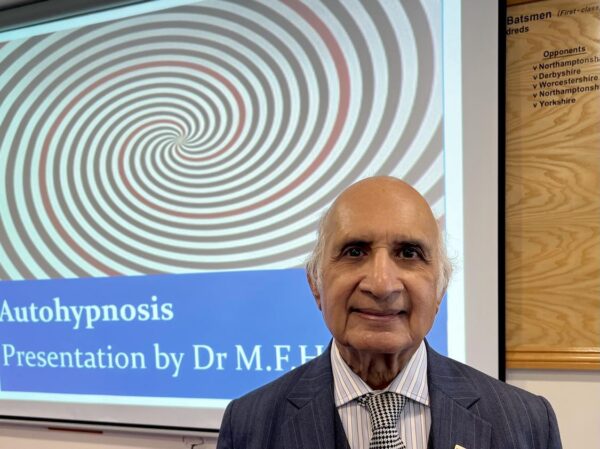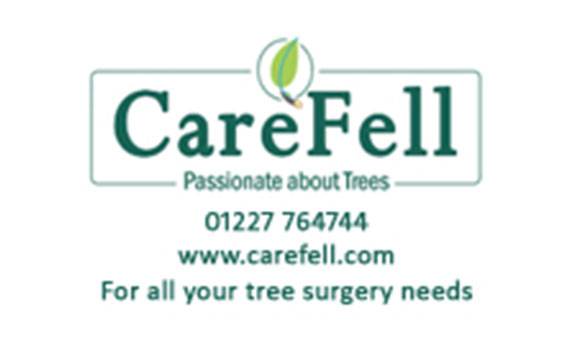“Look into my eyes. You are getting sleepy…very sleepy” … Words like this, and flamboyant stage hypnotists, are probably the first things that come to mind when we think of hypnosis. But did you know about “hypnotherapy”? We learnt a great deal at a recent talk…

Dr Farrukh Hussain is one of the longest-standing members of our Club. He’s been a member for over 50 years – quite an achievement! During that time he’s served different roles and been involved in many projects – including Rotary International’s former “3-H” (Health, hunger, and humanity) programme. He worked as a Consultant Psychiatrist at both St Martin’s Hospital and the Kent & Canterbury Hospital until his retirement. He has a special interest in the use of clinical hypnosis in psychiatric disorders – the focus of his talk.
After reminding us that it wasn’t the first time he was talking to our club – he gave a job talk about 45 years ago – Farrukh described how he decided to learn hypnotherapy after working for many years as a psychotherapist. He told us he then started to use it in his clinical practice for a variety of conditions – “everything from anxiety to birth control”. Farrukh briefly recounted cases he’d worked on, such as helping people with stammering. He also recalled how his last patient on a Friday afternoon when he was doing private practice at the Chaucer Hospital was always someone who he would help relax using hypnotherapy.
Farrukh started his presentation with an introduction to hypnosis; “Healing in a trance state is one of the oldest medical arts,” he quoted. We learnt that hypnosis as a therapy was started by a Scottish physiatrist; in 1765 German Physician, Franz Mesmer, helped popularise it. It then became so popular that many books were written on it. Later, French neurologist Jean-Marie Charcot would use hypnotherapy; in the 1950s, the British Society of Medical and Dental Hypnosis was established.
After listing the many theories of hypnosis, Farrukh spoke briefly about clinical applications, ranging from treatment of pain, insomnia and phobias to the treatment of hypertension and premenstrual tension (PMT). Over the years Farrukh has given lectures to midwives, dentists and other professionals in this regard. (Dentists, for example, might use hypnotherapy for patients with phobias.)
Next, Farrukh described induction methods – direct eye gaze and verbal suggestion being the ones referred to in the opener for this article. Sometimes drugs such as Valium are also used alongside hypnosis.
After talking about trance induction and “deepening”, Farrukh told us he was going to teach us all to relax using light hypnotherapy. “I’m not a stage hypnotist,” Farrukh reminded us. “I will teach you something you can take home with you – and keep for ever: autohypnosis”.
Autohypnosis differs from standard hypnosis: in autohypnosis you work on yourself, for instance if unable to sleep or to manage pain. Ideally, for such self-hypnosis one should “have a quiet location, draw the curtains, put the phone off the hook and use the same chair” to create the right atmosphere. “Eventually you’ll get conditioned to this,” said Farrukh.
Farrukh then asked for our tables to be moved, curtains to be drawn and lights to be dimmed. There was a buzz of anticipation among Rotarians and their guests about what was coming up.
After telling us we didn’t need to take part if we didn’t want to, and conducting a suggestibility test that would tell us if the hypnotherapy would work for us, Farrukh started the relaxation technique. [Please don’t try this without checking first with relevant healthcare professionals.]
Surprisingly, we were asked to start by frowning (“Get angry”, said Farrukh). Then at the count of three we were asked to try and relax, following Farrukh’s calm instructions: first we relaxed our jaw, then our neck and then our shoulders. Next we were asked to take a deep breath in, and then out, three times; we then took deep breaths in and held each breath until the count of three. Then we did some pelvic exercises before doing some straight leg raising, one leg at a time, under Farrukh’s guidance, three times for each leg.
Next, Farrukh said he was going to induce us into the “trance” stage. We were asked to put our right arm out (“Hitler fashion”) and then make a fist and pull out our thumb. We had to imagine a little black dot on our thumbnail and were told to keep looking at that. “In some people,” Farrukh said, “the arm will start to get heavy towards the wrist, in others towards the shoulder”. We were asked not to resist this heaviness, but just allow our arm to be pulled down slowly with gravity until we placed it on our knee.
We then closed our eyes as tight as we could and followed Farrukh’s further instructions. We were asked to use our imagination to take us to a garden (even into one from our childhood). While keeping our hand on our knee, Farrukh asked us to raise our index finger as a “yes” response to questions, our little finger as a “no” and our thumb for when we didn’t want to answer.
“Imagine it’s a nice, beautiful summer’s day,” said Farrukh. “You don’t have to work, so you can go into the garden. You hear the gentle breeze in the trees and leaves, and feel the sun shining on your brow…your cheeks…your hair. The birds are singing. Passing by the rose bed you see so many lovely flowers.” We were then asked to choose the colour of our favourite flower and give another signal once we’d done so. “You can smell the scent. Now walk to your favourite bench with your family photo album. Look through the pictures. You see picture of friends, family, parents.” We were then asked to “find” a picture of ourselves, and signal again once done. “Look at the picture: this young person is still in you; innocent, carefree, no worldly problems. Nothing to upset you, happy-go-lucky.” We were asked to look at our clothes, our shoes. “This person is still in you,” Farrukh repeated. He told us all that, with practice, we could reach this stage whenever we wanted to by thinking of the good old days.
In the next scenario, Farrukh said he would help us “solve” our problems. This time he asked us to imagine going to the seaside. “Imagine again that it’s a beautiful summer’s day, and you’ve decided to go to a seaside of your choice … say, from a holiday or your past. You’ve taken your beach towel and a cold drink with you. You go and sit on the towel by the sea, where the waves are coming in close to but not actually touching your feet. As you sit down to relax, you observe others, you see seagulls, you feel the cool breeze, you see the sea’s white froth.” We were asked to let other thoughts come into our mind if they came. “Don’t worry about these other thoughts. You are relaxing,” said Farrukh. “Now, get rid of the first problem by writing it with your fingers in the sand. As the waves come, they take away as much of that problem as you want.” We were told we would feel better and get better at letting go of our problems using this technique.
Farrukh asked us to stay in the relaxed state for a few more minutes; for those struggling to relax Farrukh suggested imagining sitting at the top of 10 stairs. He would count slowly from 10 to 1 as we descended the stairs one-by-one, taking deep breaths with each drop. “The further down you go, the more relaxed you will feel”. Next, once we were all relaxed, we were asked to stay relaxed for a further five minutes. Finally, after the minutes had elapsed, Farrukh brought us out of the trance by counting backwards from five to one, telling our eyelids to slowly open as he did so. At the count of “one” we were all to be wide awake!
It has to be said it was a very different experience for a Rotary meeting and several people commented that they felt relaxed. One of our members, who wears a monitor for his heart rate, even said his heart rate had steadied during the “light” relaxation.
Finally, after a few questions from the floor, Rosemary brought the session to an end by thanking Farrukh for the unusual presentation – remarking how relaxed she felt as she did so.
Picture: Farrukh, pictured before his talk. Picture credit: Rotary Club of Canterbury.
Please note: the publication date of this article has been backdated due to a website upgrade.


